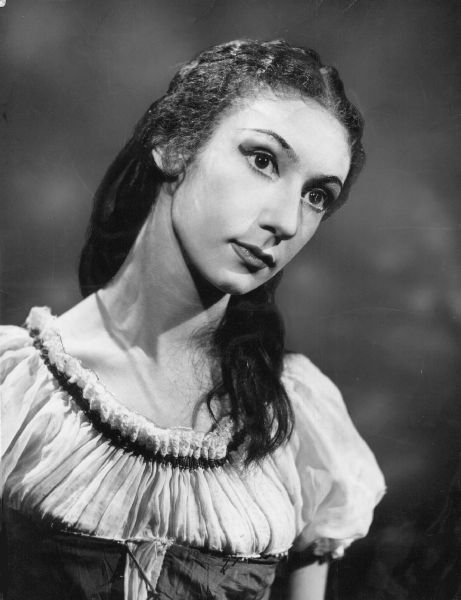|
Beryl Goldwyn Reviews |
|
||||||||||
|
|
BALLET RAMBERT "GISELLE" Giselle is a stern test for a young company but one worth attempting. For the latter half of this week the Ballet Rambert, now dancing at Sadler's Wells, makes this classic ballet the central part of its programmes. Hugh Stevenson's sets are attractive, and Adam's music is competently, sometimes more than competently, played. The mime, moreover, is clearly and effectively conveyed. The test is the title role, and the company may count itself fortunate in Miss Beryl Goldwyn ; her youth and zest are eloquent qualities for the portrayal of the blithe dancer in the first act, and her striking face carries a suggestion of, brooding that helps to explain the sudden decline of an apparently extrovert village maiden. Giselle's only joy was dancing; Miss Goldwyn's performance hints that the polka was only an outlet for a heroine deeply troubled within. Her natural grace of carriage, and the effortless line which allows her. limbs to shape themselves, in attitude or in motion, into always fluent and satisfying patterns, help her to bridge the gap between the Giselle of both acts. When she rises from the tomb, or rather is revealed before it, she begins to dance with the dignity and poise of the Wili; but these are qualities, on a more ethereal plane, that have marked her dancing in pas-de-deux and solo when she was yet alive. Miss Goldwyn is a gifted and charming dancer; she can act too, as a convincing representation of the mad scene vividly showed. Mr. John Chesworth made a likeable, handsome Albrecht, and Miss Ann Horn a capable Myrtha, who, however, could not make the Wili Queen’s famous leaps appear dignified; the difficult enchainement simply suggested that the stage was small. "The Times" 7th August 1953
|
|
|||||||||
|
|
AN OUTSTANDING GISELLE Miss Goldwyn of the Ballet Rambert Giselle is the most difficult of the great ballets to realize satisfactorily. Its style, French romantic ballet, is artificial and restricted by the standards of modern balletic experience; the two acts, together disparate in manner, have to be integrated by the name-part, the fey country girl who dies to become a Wili, and who in the course of the drama changes from a character dancer into a grand heroic ballerina. We have seen some fine Giselles in London. the Ballet Rambert, who are currently giving a season at the Sadler's Wells Theatre, opened from strength last night with their version of this classic; the production is as convincing in style, on its own modest scale, as any that we have seen here for some years, and in Miss Goldwyn the company has the most moving Giselle that Britain can offer. Any company in the world would be proud to show such a performance; we may all feel it characteristic and apt that such a Giselle should come, not from the Royal Ballet, but from this small gallant company which has played so formative a part in the evolution of British Ballet. The corps de ballet is small and the reproduction of the choreography is evidently designed to fit a small stage; but everything whether mime or enchainment is calculated to make a dramatic point. We have admired Miss Goldwyn's impersonation of Giselle in the past; it has developed steadily to a point in which every detail is realized in the frame of a deeply moving conception. It is in the second act that her performance has grown most remarkably; it is poised now without the ultimate classical grandeur that some ballerinas have shown; but with a strength of personality and telling vividness that convince both in context and gesture by gesture. In the first act too the shy, simple, intellectually retarded girl, on whom Miss Goldwyn first based her interpretation, has gained in lively and artistic relevance - the episode of "He loves me, loves me not." is a heart-wound that cannot be parried, and the mad scene is so intensely and exquisitely felt that the tears rise unbidden to a hard-bitten gorge. Miss Goldwyn has allowed a fine and interesting performance to develop into a great one. There are some shortcomings - Adam's music is rattled through at breakneck pace by a small, raucous band under Mr. David Ellenberg; the corps de ballet is rather tentative; the other soloists are expert but not outstanding. It is still a performance that friends of ballet can love and admire and be moved by. "The Times" May 1959 |
|
